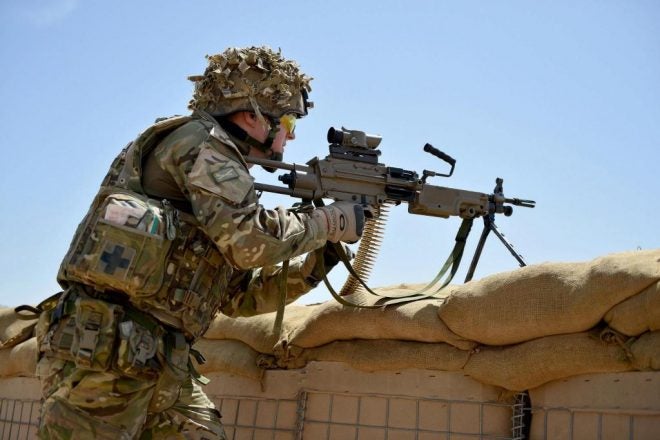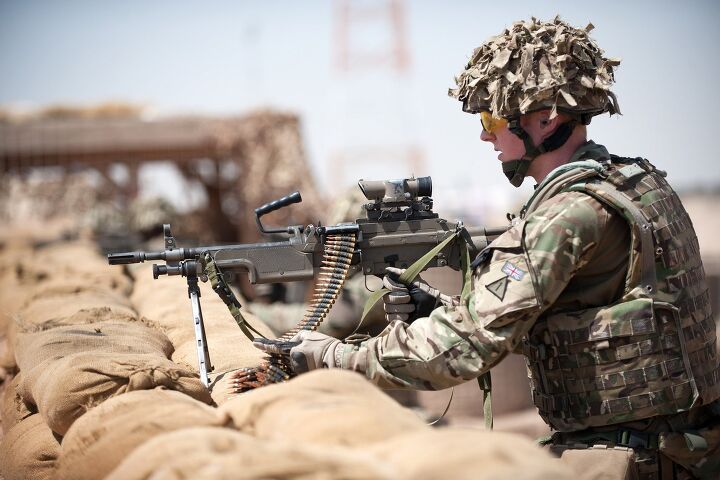The British Army is set to move away from its use of the FN Para Minimi or L110A2/A3 at the fire team level. During a seminar at the 2018 Future Soldier Technology conference, held in London 12th-14th March, the CO of the British Army’s Infantry Trials and Development Unit confirmed that the L110A2/A3 would be dropped. The move will widen the debate around suppressive vs precision fire.
Talk of abandoning the 5.56x45mm Minimi began back in 2016 as an effort to ‘fight light’ and remove some of the weight burdens at the dismounted infantry section level. At the seminar last week Lt.Col. Nick Serle of the Infantry Trials and Development Unit (ITDU) explained that “We want to reduce the burden and there are better ways to provide suppression through precision.” The L7A2 general purpose machine gun, however, will remain in use at the platoon level.
The move away from belt-fed light machine guns mirrors that of the US Marine Corps 2010 decision to transition away from the M249, their own version of the Minimi, to the M27 Infantry Automatic Rifle for higher rates of precision fire. In British terms, the infantry is moving back towards the initially envisaged role of the L86 Light Support Weapon.

Member of the 1st Mechanized Brigade with an L110A2 equipped with a standard SUSAT sight, Afghanistan, 2013 (MOD/British Army)
The British Army adopted the L110A2 in 2004, following operational use in Afghanistan, to replace the L86A2 Light Support Weapon. With a 100 round belt, the L110A2 weighs 8.5kg or 18.7 lbs. With British operations winding down in Afghanistan the debate about precision vs suppression has raged with Lt.Col. Serle admitting the decision to remove the LMG from fire teams had been taken with a ‘heavy heart’.
Suppression is a difficult factor to quantify. The decision appears to be based on a combination of collated data and input from troops who have used the weapon in the field. Testing in 2016 found that the LMG was not sufficiently accurate to justify the system’s (gun and ammunition) additional weight. According to MilTech Lt.Col. Serle noted that the L110’s true maximum effective range is 250m, perfect for close to intermediate range engagements but the accuracy decreases rapidly at longer ranges.
Current thinking suggests that the men armed with the current L85A2, and the upcoming L85A3, equipped with L123A3 (the Heckler & Koch AG-36) under barrel grenade launcher are better able to fulfill the L110’s role of suppressing targets out to 300-400m.

L129A1 7.62x51mm Sharpshooter Rifle fitted with an ACOG 6×48 (Stuart Hill/MOD)
MilTech has also reported that at another Future Soldier Technology seminar Lt.Col. Alex Hutton, Senior Requirements Manager of Soldier Training and Special Programmes, Defence Equipment and Support confirmed that in addition to relying more heavily on the individual rifleman the British Army will seek to increase its number of 7.62×51mm L129A1 designated marksman rifles. The ‘Sharpshooter Rifle’ entered service in 2010 and the British Army currently has over 3,000 in service. Manufactured by Lewis Machine & Tool, a tender for more L129A1’s has not yet been announced. It seems that the British Army now firmly believes that precision fire is the key to suppression.
Source:
‘Precision vs Suppression’, Military Technology, retrieved 13/03/18, from source
‘Weight Continues to be the Biggest Burden’, Military Technology, retrieved 13/03/18, from source
‘Infantry Modernisation’, UK Armed Forces Commentary, retrieved 22/03/18, from source
 Your Privacy Choices
Your Privacy Choices
